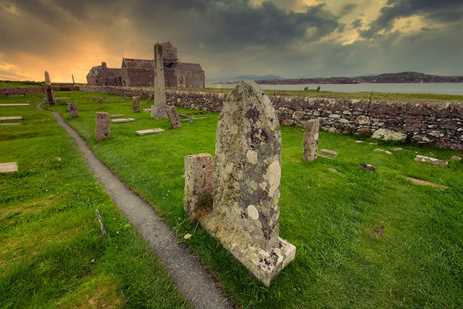Discovering an entirely new angle to a favorite, or well-known, destination is a special highlight of travel. Such is the case with these fascinating places which we explore on many of our European voyages. Each one holds a secret identity, the result of ancient cultural influences that add a layer of unique exploration possibilities, and the chance to discover two cultures in one stop. Read on to learn some new things you may have never known about familiar destinations. Get Inspired By Photos, Videos, Webinars, Stories, And Exclusive Offers. Sign Up
This Tiny Scottish Isle Has Irish Christian Roots
With a year-round population of just 100 citizens, Iona, a petite island off the western coast of Scotland, doesn’t sound at first like a particularly noteworthy stop. But this isolated Hebridean island has a long and fascinating history that makes it well worth a visit: Iona is considered the birthplace of Christianity in Scotland. An exiled Irish monk, Columba, founded a monastery here in 563, bringing both Irish and Christian culture to much of the country from his home base on Iona. You can step back into this history here with a visit to a 12th-century church, or explore St. Oran’s royal burial grounds, where Celtic high crosses mark the graves of generations of Scottish kings including the real Macbeth.
Visit Iona on Exploring Scotland’s Wild Isles: Shetlands, Orkneys & Inner Hebrides >

Nordic Vikings Once Occupied Scotland
Back in the Middle Ages, Vikings ruled the seas, and the Orkney Islands, now part of Scotland, were a stronghold of the Kingdom of Norway. The Nordic Vikings occupied the area here for centuries and you can see their cultural remains at Neolithic Skara Brae, a 5,000-year-old stone-slab village predating Stonehenge and the Pyramids, as well as in the mysterious megaliths and prehistoric burial mounds that comprise the Ring of Brodgar. Then step inside the medieval St. Magnus Cathedral, founded by Viking Earl Rognvald, which took nearly 300 years to complete.
Visit Orkney on Norwegian Fjords and Scottish Isles >

Germanic-Frank Settlers Influenced Antwerp
Antwerp has a sparkling image as the world’s diamond capital, processing 80 percent of the world’s raw diamonds. The beautiful Belgian city is also one of the largest river ports in Europe and its ancient history is equally impressive. The city’s medieval origins date back to when Gallo-Roman and Germanic-Frank settlers visited in the early 3rd through 5th centuries. In fact, the name “Antwerp” points directly to Frank (early German) heritage: Anda meaning “against” and werpen to “throw;” historians think this means the act of throwing weapons at a fortress—most likely the medieval Het Steen castle. To see remnants of the city’s medieval past, go deep, both historically and physically, to the Ruien, Antwerp’s underground canal system. Above ground, the Grote Markt’s triangle shape and radial street plan are remnants of early Middle Age design.
Visit Antwerp on North Sea Voyage: Northern Europe and the Normany Beaches >

Saint Malo, France Was Established by Welsh Monks
The stunning walled city of Saint Malo may seem quintessentially French at first glance, but peer inside its staggering granite walls and down the cobblestone streets and you’ll discover another side to this historic city on the coast of Brittany. Saint Malo’s current location (an earlier nearby settlement dates to the 1st century BCE) was chosen by refugee monks fleeing Wales in the 6th century, including one named Maclou, later canonized as Saint Malo. The walled city dramatically situated on a rocky promontory surrounded by the English Channel is surrounded by ramparts dating back to the 12th century.
Visit Saint Malo on Navigating the Atlantic Coast: Brittany, Wales & England’s Channel Islands >

There Are Celtic Influences in Spain
Spain’s northwestern corner holds great beauty as well as fascinating history. Vilagarcia de Arousa is the coastal gateway to the region known as Galicia, which boasts its own language and customs (not to be confused with the neighboring Basque region) that harken back not to Mediterranean Europe, but to a rich Celtic past. The name Galicia is imbued with Celtic history, deriving from an ancient tribe Gallaeci, who lived here as far back as the prehistoric Bronze Age. Spend some time in the area and you’ll start to notice a number of similarities between Galicia and Ireland and Scotland, including many words that have Celtic origins and festivals with “pagan” origins—including the Noche de San Juan, the summer solstice, where both pyres and bagpipes fill the night sky.
Visit Vilagarcia de Arousa on Culture and Cuisine from Porto to Basque Country >





